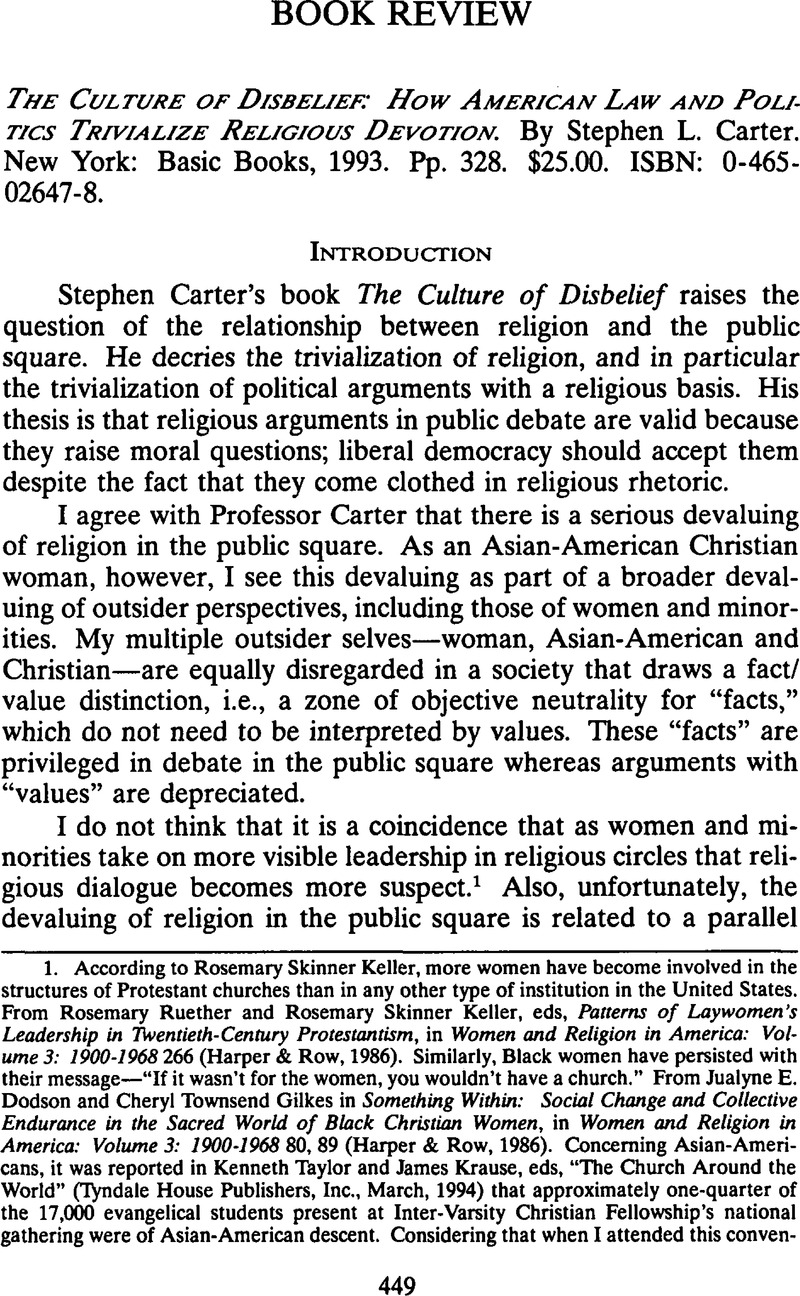No CrossRef data available.
Published online by Cambridge University Press: 24 April 2015

1. According to Rosemary Skinner Keller, more women have become involved in the structures of Protestant churches than in any other type of institution in the United States. From Ruether, Rosemary and Keller, Rosemary Skinner, eds, Patterns of Lay women's Leadership in Twentieth-Century Protestantism, in Women and Religion in America: Volume 3: 1900-1968 266 (Harper & Row, 1986)Google Scholar. Similarly, Black women have persisted with their message—“If it wasn't for the women, you wouldn't have a church.” From Dodson, Jualyne E. and Gilkes, Cheryl Townsend in Something Within: Social Change and Collective Endurance in the Sacred World of Black Christian Women, in Women and Religion in America: Volume 3: 1900-1968 80, 89 (Harper & Row, 1986)Google Scholar. Concerning Asian-Americans, it was reported in Taylor, Kenneth and Krause, James, eds, “The Church Around the World” (Tyndale House Publishers, Inc., 03, 1994)Google Scholar that approximately one-quarter of the 17,000 evangelical students present at Inter-Varsity Christian Fellowship's national gathering were of Asian-American descent. Considering that when I attended this convention in 1976 that attendance was overwhelmingly white, this shift says a lot to me about the changing color of American evangelicalism.
2. Carter, Stephen L., The Culture of Disbelief: How American Law and Politics Trivialize Religious Devotion, 230 (Basic Books, 1993)(hereinafter Carter, Disbelief)Google Scholar.
3. For a discussion of the relation between religion and knowledge, see Clouser, Roy A., The Myth of Religious Neutrality 78–82 (U of Notre Dame Press, 1991)Google Scholar.
4. Carter, , Disbelief at 215 (cited in note 2)Google Scholar.
5 . Id at 219.
6. Id at 224.
7. Id at 226.
8. Id at 232.
9. For a brief discussion of Christian epistemology, see Van Til, Cornelius, An Introduction to Systematic Theology 21–30 (Presbyterian and Reformed, 1974)Google Scholar. According to Van Til, ultimately all the facts in the universe are either what they are because of their relation to the system of truth in the Bible or they are not. As set forth in the Bible, God is the source of all space-time factuality. “Reason” and “fact” presuppose God's existence and control over the universe.
10. See Bodde, Derk and Morris, Clarence, Law in Imperial China 19–23 (U of Pennsylvania Press, 1967)CrossRefGoogle Scholar.
11. 1 Corin 6:1-8.
12. Rifkin, Janet, Toward a Theory of Law and Patriarchy, 3 Harv Women's L J 83 (Spring, 1980)Google Scholar.
13. Id at 83.
14. Id at 92.
15. Id at 88.
16. Id at 86.
17. Gabel, Peter and Harris, Paul, Building Power and Breaking Images: Critical Legal Theory and the Practice of Law, 11 Nyu Rev L & Soc Change 369 (1983)Google Scholar.
18. Id at 396.
19. Id at 406.
20. Id at 410.
21. Id at 401, 410.
22. Id at 408.
23. Interestingly enough, Messrs. Gabel and Harris do raise a point about religion in their piece. They state that whereas in the past religion shaped consciousness and acquiescence to a status quo, law now plays that role. While I do not agree with the authors about the nature of religion, I do agree with them concerning the nature of law. Law is inherently religious.
24. Messrs. Gabel and Harris also decry an excessive preoccupation with “rights-consciousness” which reinforces alienation and powerlessness. This, unfortunately is the tack that religionists so often pursue. We are obsessed with our “right” to prayer, religious freedom, etc.
25. Carter, , Disbelief at 68 (cited in note 2)Google Scholar.
26. See Noll, Mark A., The Scandal of the Evangelical Mind (W.B. Eerdmans, 1994)Google Scholar.
27. See Marsden, George M., The Soul of the American University: From Protestant Establishment to Established Neutrality (Oxford U Press, 1994)Google Scholar.
28. I am uncomfortable with the term “family values.” I think that “covenant values” or “community values” might be a more appropriate way to express Biblical teaching.
29. The Moral Majority movement is a prime example of this.
30. See Skillen, James W., Recharging the American Experiment: Principled Pluralism for Genuine Civic Community (Baker Books, 1994)Google Scholar.
31. Carter, , Disbelief at 214 (cited in note 2)Google Scholar.
32. At a recent meeting at which Richard Mouw, the president of Fuller Theological Seminary addressed members of the Christian Legal Society in Los Angeles, he gave an example of the need for empathic dialogue. He recounted the story of an ardent and outspoken pro-life activist. One day she ceased all involvement with the pro-life movement. Later on, it was discovered that her daughter had been raped and had undergone an abortion. President Mouw wondered if there could be some way in which this woman, and others involved in the pro-life and pro-choice movements could be involved in empathic dialogue—dialogue with conviction, but nevertheless, empathy for the other side.